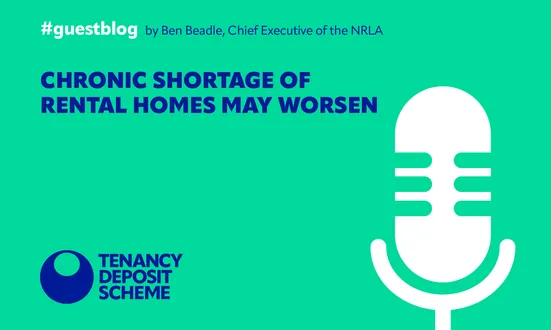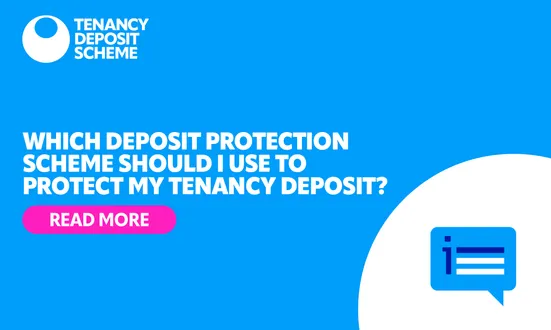
At the Tenancy Deposit Scheme we understand that letting a property is a big responsibility, and we’re committed to providing you with the right guidance to help make deposit protection as seamless as possible.
So in the spirit of Christmas, here are our 12 essential tips to get deposit protection right, in the style of the 12 days of Christmas!
 1. Remember, you must protect your tenant’s deposit within 30 days of receiving it
1. Remember, you must protect your tenant’s deposit within 30 days of receiving it
Protecting a tenant’s deposit is a mandatory part of letting a property. You can only protect a deposit with a government-approved provider, such as the Tenancy Deposit Scheme.
 2. You have 30 days from receipt of deposit, to issue the prescribed information (PI).
2. You have 30 days from receipt of deposit, to issue the prescribed information (PI).
Once you have protected your tenancy deposit in one of our deposit protection schemes, TDS will issue you with your prepopulated PI. You must give this to your tenant (and any other person who contributed to the deposit) within 30 days of receipt of the tenancy deposit.
 3. There are two types of deposit protection – Insured and Custodial. What is your preference?
3. There are two types of deposit protection – Insured and Custodial. What is your preference?
Insured schemes allow agents and landlords to hold the deposit in their own account and pay a small fee per tenancy to guarantee the deposit. The fee varies, depending on a number of factors such as deposit value or if you are eligible for a discount due to professional memberships. The Tenancy Deposit Scheme offers both NRLA and Propertymark members preferential rates in our Insured Scheme.
Custodial protection is a free service. The deposit protection scheme holds the deposit for you, meaning that for the duration of the tenancy, both the landlord and the tenant can rest easy knowing the deposit is secured. At the end of the tenancy, both parties contact the scheme to release the funds. The Tenancy Deposit Scheme offers a switching service for agents and landlords who wish to transfer to our free Custodial Scheme. Click here to find out more.
Whichever method you choose you can only protect a deposit with a government-approved provider, such as TDS.
 4. Renting to joint tenants? Find out how the deposit is affected.
4. Renting to joint tenants? Find out how the deposit is affected.
A deposit is protected for a tenancy as a whole and joint tenants will be jointly and severally liable. This means that if one tenant damages something or doesn’t pay their rent, all tenants are equally responsible for putting it right.
If you are letting a property on a room-by-room basis with common facilities such as student accommodation, the deposit should be protected separately for each tenant. You will not be able to use other tenants’ deposits against another tenant’s liability.
 5. Communication is key – make sure you give us a tenant’s email address when you register the deposit.
5. Communication is key – make sure you give us a tenant’s email address when you register the deposit.
Communication can often be the difference between a successful tenancy and a disputed deposit return. By providing the tenant’s email address to us at the time of deposit registration you will be opening up the doors for communication.
In our custodial scheme, we will send the tenants log-in details so that there are no delays in their participating in the deposit repayment process at the end of the tenancy. Similarly, in our insured scheme, having an email address will mean that we can gather evidence and communicate with all parties throughout any potential deposit dispute.
 6. Make sure you’re providing the correct documents at the start of every tenancy.
6. Make sure you’re providing the correct documents at the start of every tenancy.
When letting a property, the agent or landlord is legally obliged to provide a selection of documents at the beginning of every tenancy. In addition to including mandatory documents such as the energy performance certificate (EPC) and gas safety certificate, many landlords find it useful to include photocopied manuals for any appliances supplied to the tenants (e.g. microwaves).
A selection of mandatory documents:
- Prescribed information relating to the tenancy deposit
- Energy performance certificate (EPC)
- Gas safety certificate
- An up to date right to rent guide
 7. Cleaning is not subject to fair wear and tear, but make sure you include cleanliness on the inventory.
7. Cleaning is not subject to fair wear and tear, but make sure you include cleanliness on the inventory.
When evaluating the property at the end of a tenancy, it is reasonable to expect your tenants to have cleaned to the same standard as it was at the start of the tenancy.The Tenancy Deposit Scheme recommends that cleanliness is listed as a separate requirement in its own right within the inventory check-in report, to ensure that appropriate consideration is given to the general cleanliness of your property.
If you have had the property professionally cleaned and the carpets shampooed, include this on the inventory; similarly ‘cleaned to a domestic standard’ is much more descriptive and less subjective that just ‘clean and tidy’. For help on inventories, check-in and check-out reports, please look at our free guide.
 8. Don’t leave out the garden when doing an inventory – gardening can be expensive!
8. Don’t leave out the garden when doing an inventory – gardening can be expensive!
The condition of a garden can be an easy one to forget, but a costly mistake to make. At TDS, gardening is one of the top 5 reasons for deposit disputes at the end of tenancy, so ensure you have provided clear guidelines on what you would like tenants to do for upkeep – including what they may not do. It’s easy to cut the grass if the tenant forgets, but you will find it much harder to put branches back on trees in the case of over-zealous gardening. Consider including a gardening clause in your tenancy agreement.
 9. To avoid a dispute with tenants send a friendly reminder about cleaning before their check-out.
9. To avoid a dispute with tenants send a friendly reminder about cleaning before their check-out.
The number one reason for disputes at TDS is cleaning, so can often be avoided if both parties communicate openly from the beginning about their expectations. Sending a friendly reminder to your tenants is a good way to prompt them into action and help prevent any misunderstandings.
 10. Has the tenant moved out mid-way through the month? Find out how to calculate pro-rata rent.
10. Has the tenant moved out mid-way through the month? Find out how to calculate pro-rata rent.
Calculating rent when a tenant moves out can be a difficult task, but it is important to get it right. There is a simple formula to use, to calculate pro-rata rent.
(Months’ Rent * 12) / Days in the Year) * The number of days the tenant needs to pay
Let’s assume that it’s a leap year, so there are 366 days this year. Your monthly rental fee is £750 and the number of days that the tenant needs to pay is 10.
Therefore: ( (£750*12)/366)*10 = (£9000/366)*10 = £24.59*10 = £245.90
 11. When is wear and tear not fair? Find out what our adjudicators think.
11. When is wear and tear not fair? Find out what our adjudicators think.
An important legal concept is that a landlord should not be put in a better position at the end of the tenancy then they would have been if the tenant had not broken the terms of the tenancy agreement. For example, if the carpet was 2 years old when the tenant moved in and stained at the end of the tenancy, the landlord can seek compensation accordingly, but not for a brand new carpet. The amount of wear that is fair will depend on a number of factors including the length of the tenancy, number of occupants, location of damage, etc., but does not extend to cleanliness. A worktop can be 5 years old and scratched, but still able to be cleaned.
 12. Prevent disputes by communicating with your tenants before issues have the chance to escalate.
12. Prevent disputes by communicating with your tenants before issues have the chance to escalate.
Disputes can be a difficult process for everyone involved. The best way to deal with a dispute is to prevent there from being any issues in the first place. Open communication is the key to a happy tenancy, both for you and your tenants. Be very clear about your expectations and their responsibilities. Provide a check-in and a check-out check report, and stay in touch with the tenant throughout the tenancy. By having these in place, it may also help you if anything does go to an adjudicator as you will be able to show evidence that you have been trying to communicate with the tenant from the start.
Simple Deposit Protection
Joining TDS is simple!
It only takes a few minutes to join today.
We’ve also made this easy if you’d like to transfer from another scheme. Visit our switch page and we’ll handle the rest.
Other news stories


